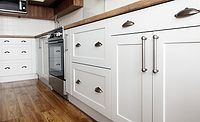VOC Directive Heralds Change for UV-Curable Wood Coatings

Most UV-curable wood coating formulations used in Europe contain some form of volatile component, with very few being fully solvent free. These solvent levels can range from small levels to up to 70% in some polyester-based formulations. Coatings with a high solvent content are cheaper per kg and per coated area, and are more common in southern Europe -- mainly Spain and Italy, two of the largest European wood coating countries.
The VOC directive is set to drive the use of solvents down, which will force end users to change to more expensive, lower solvent alternatives. Depending on the application, the solvent consumption threshold varies. Companies that are bound by the VOC directive, therefore, vary between half- ton consumption for some processes to 25 tons in others. It is rarely made clear that many UV-curable wood coatings still contain high levels of solvent.
Prices for UV-curable wood coatings depend primarily on the amount of solvent in the coating. The solventborne coatings can be a factor of 10 cheaper than solvent-free acrylate formulations. The average price is rising as sales of these cheaper materials dwindle, says Brian Balmer, Frost & Sullivan industry analyst.
The only truly solvent-free alternatives are powder coatings. The market is currently small, but the potential for these materials is enormous since they offer a combination of processing and properties not available from any other alternative. Until recently, their use had been limited to metal substrates such as office furniture. But, with the introduction of Infrared lamps, which induce less heating of the substrate, we are seeing their use on MDF and plastic substrates. The overall impact of these technologies on growth of UV coatings in the industry will remain low for some time to come, but will be competing directly against the more developmental UV powder coatings.
The study, titled "European UV Curable Coatings Market Report", was scheduled to be published May 2001.
For more information, contact Frost & Sullivan, 4100 Chancellor Court, Oxford Business Park, Oxford, OX4 2GX, United Kingdom; phone Bill Stringer, +44 (0) 1865 398651, or e-mail bill.stringer@fs-europe.com.
Looking for a reprint of this article?
From high-res PDFs to custom plaques, order your copy today!






